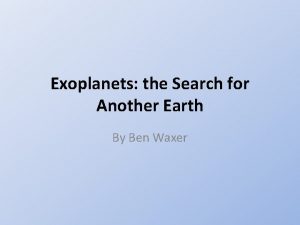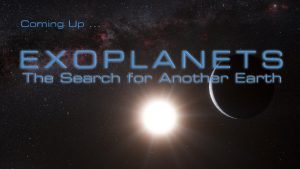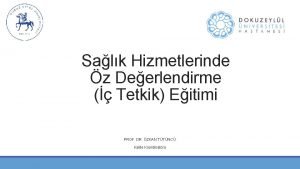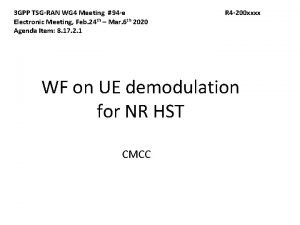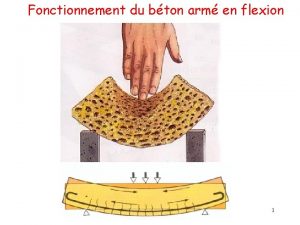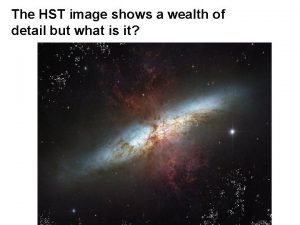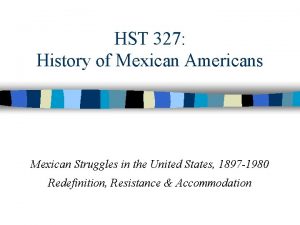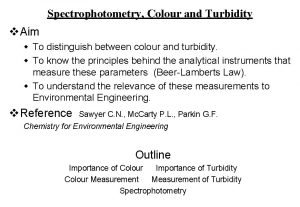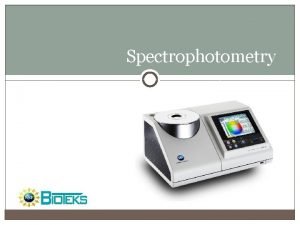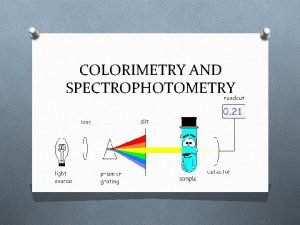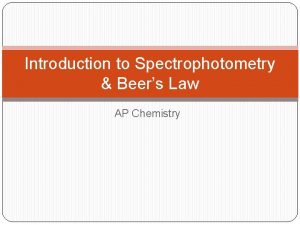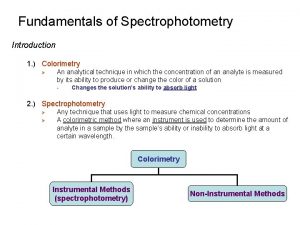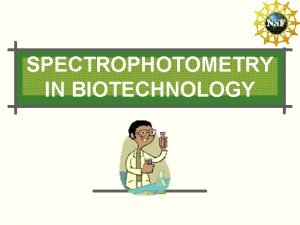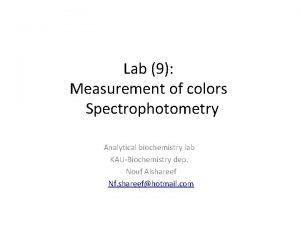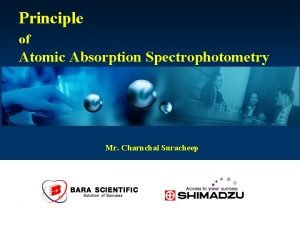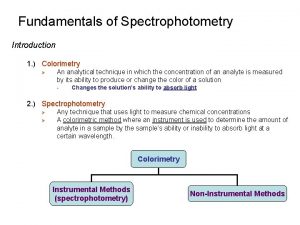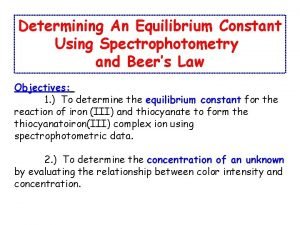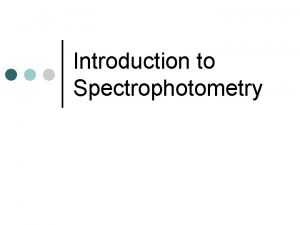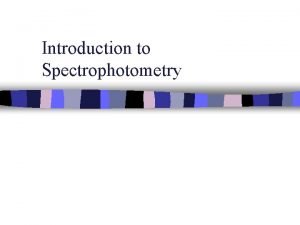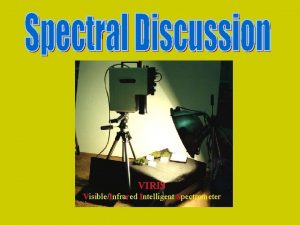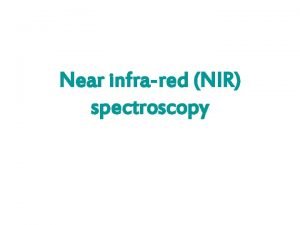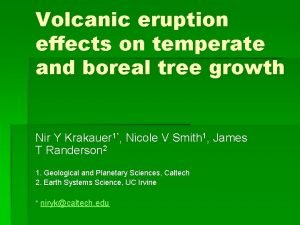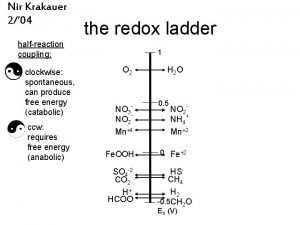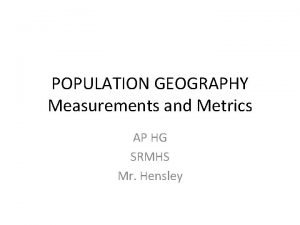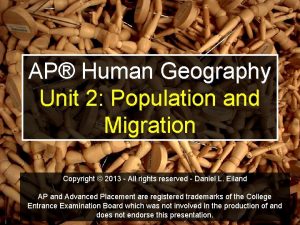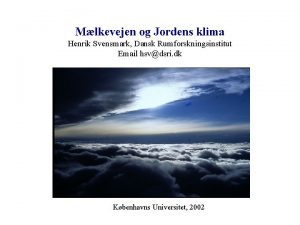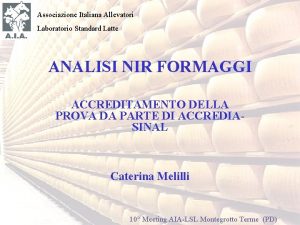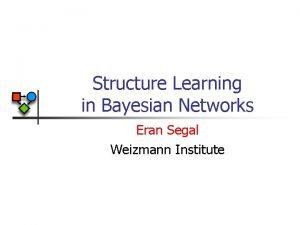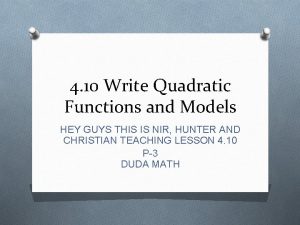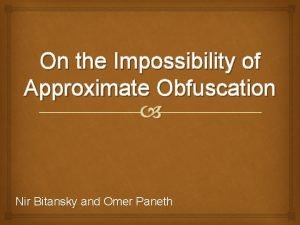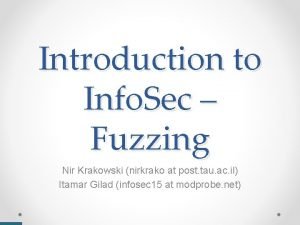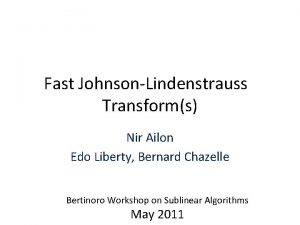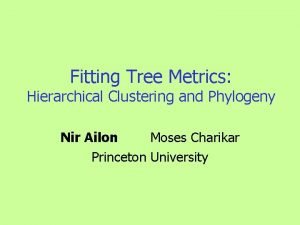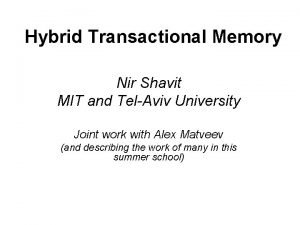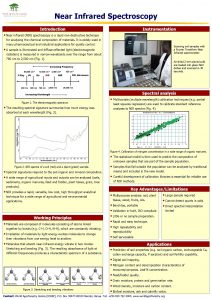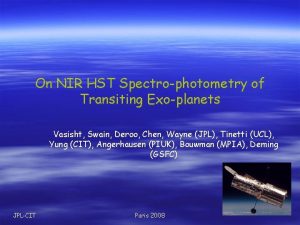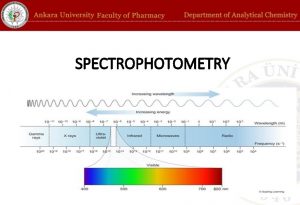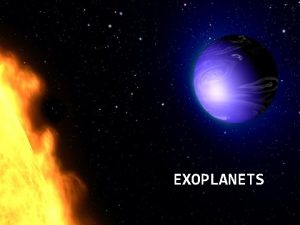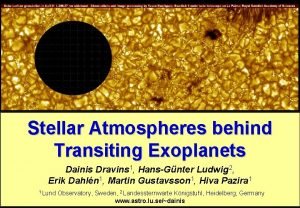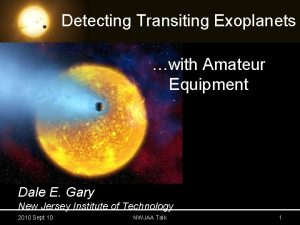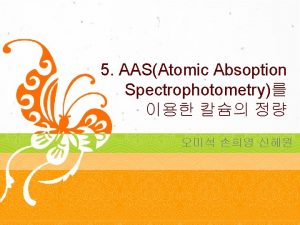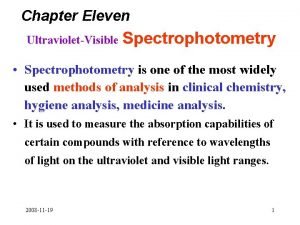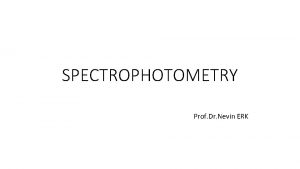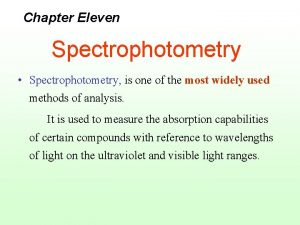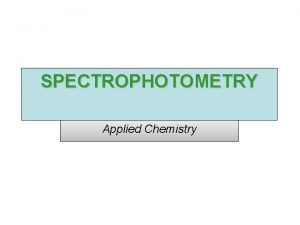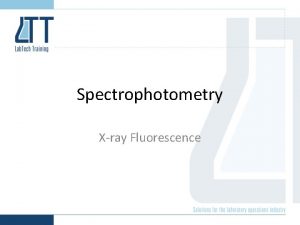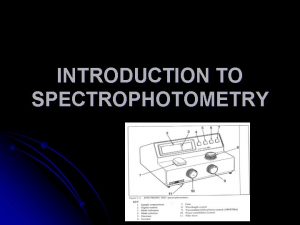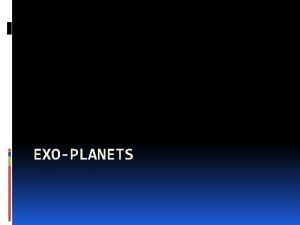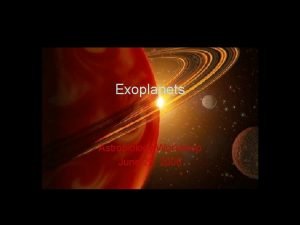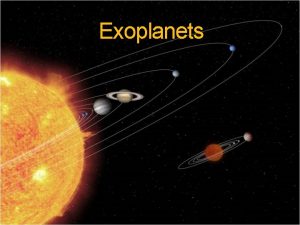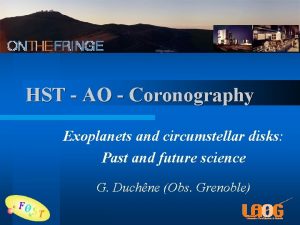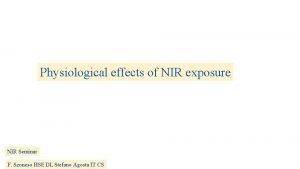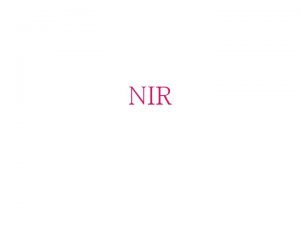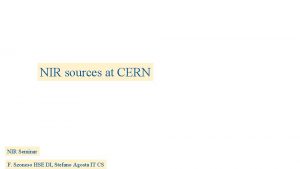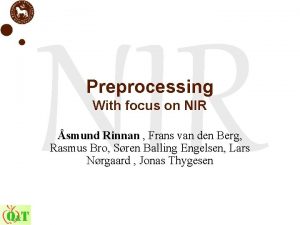On NIR HST Spectrophotometry of Transiting Exoplanets Vasisht








































- Slides: 40

On NIR HST Spectro-photometry of Transiting Exo-planets Vasisht, Swain, Deroo, Chen, Wayne (JPL), Tinetti (UCL), Yung (CIT), Angerhausen (PIUK), Bouwman (MPIA), Deming (GSFC) JPL-CIT Paris 2008

Outline § Motivation for NIR objective mode, time-resolved spectroscopy § Instrumental issues > General issues confronting shot-noise limited spectroscopy > Hubble specific limitations § Modeling and removal of instrumental limitations § Spectroscopy of the emergent flux from HD 189733 b (Swain, Vasisht, Tinetti, Deroo, Yung et al. , accepted Ap. JL) JPL-CIT Paris 2008

Spectroscopy with NICMOS § Slitless Grism spectrograph between 0. 82. 5 microns § Camera 3 – Coverage by 3 grisms located in filter wheel – R = 200 native spectral resolution – Camera 3 is severely under-sampled at 0. 2”/pixel (~λ/D @ 2 um, 52” FOV) § Exoplanet datasets have now been acquired with all grisms – G 141 on HD 209548 b (Brown et al. in 2005, unpublished) JPL-CIT Paris 2008

Scientific Rationale § NIR Emission Spectroscopy (λ ~1 -2. 5 um; Spitzer 3 -30 um) – Observable: Falling but favorable flux contrast (< 3 um) – Energetically Important: Maximum νFν (for emergent flux) – Decreased stellar shot-noise – NIR photosphere at greater pressure depths (0. 1 -1 bar) – Molecular activity: ro-vib bands of major species § Again some of the same advantages apply for transmission spectroscopy – Reduced opacity from small particle scattering JPL-CIT Paris 2008

Hot, Cold or Cloudy Hot T = 1750 K dayside reradiation JPL-CIT Paris 2008 Seager et al. 2005 Homogenous clouds

Active (common) C, N, O molecules Lodders & Fegley 2002 � JPL-CIT Paris 2008

Hubeny & Burrows 2008 JPL-CIT Paris 2008

§ Molecular spectroscopy -> atmospheric physics – Atmospheres are a window to planetary composition, may have clues to evolutionary history – History of the planet can give rise to a range in core sizes, heavy element abundances, and abundance ratios – Relative fractions of refractory and volatile materials should reflect upon § Parent star abundances, history of formation, migration (? ) JPL-CIT Paris 2008

Part II – Photometry with HST 1. Detector anomalies 2. Optical anomalies JPL-CIT Photometric systematic noise Paris 2008

NICMOS Detector Effects § Stress induced structure in the response § Pixel-to-Pixel stochastic response variations § Intrapixel structure in the response § T-dependence Figer et al. 2002 JPL-CIT Paris 2008

Large scale structure NIC-3 is undersampled PAM Defocus provides some “Immunity” This sets R ~ 40 Watch for structure under spectrum. Flats can remove some of this power JPL-CIT Paris 2008

Small-scale structure and MTF Finger et al. 2000 JPL-CIT Paris 2008 Stiavelli et al.

Relative Photometry Evaluate in some statistical fashion JPL-CIT Paris 2008

Relative Photometry k-space § Variance is integral over spatial frequencies of – Power spectrum of the detector response apodised by § 1. Power spectrum of the illumination § 2. 1 -cos() high pass filter JPL-CIT Paris 2008

Diffraction PSF Intrapixel gain Defocused PSF by Ray Tracing: Note this is a PSD 1 -cos(k dx), dx = 0. 1 pix 14/08/2008 Paris 2008

Implications § Significant substructure in the psf (ILS) – At spatial frequencies of D/λ, D/2λ etc – Due to diffraction – D/λ ~ 1/pixel – Mostly preserved in cross-dispersion axis § Varies with wavelength – For shorter λ, higher spatial frequencies § Can interact with sub-pixel structure JPL-CIT Paris 2008

§ Beam wander § In x (spatial) and y (spectral) § Repositioning errors – Filter wheel positioning – Rot. about un-deviated ray § Orbital phase PSF modulation – Proxy (Gaussian FWHM) § Array response variations – QE with temperature – JPL-CIT DISCRETE OFFSETS X, Y, θ, T PERIODIC ~ 1%/K (2. 5 micron), 3%/K (1. 5 micron) σ Paris 2008

dx, dy, dθ Σ d. I d. T dσ § Biggest headache is image motion § Repositioning errors (Monte Carlo) – δx, δy ~ 0. 1 pixel; linear perturbations – δx, δy > 0. 25 pixels; large higher order errors (> 10 -4) § Generally few usable orbits per visit – Adding 2 nd order terms to expansion is problematic JPL-CIT Paris 2008

JPL-CIT Paris 2008

JPL-CIT Paris 2008

Orbit 1 JPL-CIT Paris 2008

Other Systematics § Optical effects – Flux-migration between grating-orders § § § JPL-CIT Response of interference filter Geometrical shadowing by grooves Woods anomalies Paris 2008

Part III – Observations of HD 189733 b JPL-CIT Paris 2008

State-Variables HD 189733 b angle position defocus temperature Paris 2008

Iterative Multivariate Fits Noise Light curve Design Matrix Model vector JPL-CIT

Raw periodogram Data Modeling-III Post-fit residuals JPL-CIT Paris 2008

Lightcurves Broadband 1. 5 To 2. 5 um K band with Common mode Noise removed Final K band Lightcurve JPL-CIT Paris 2008

HD 189733 (Basic Data) § HD 189733 (K 1 -K 2 V) – T ~ 5000 K – 19. 3 pc – > 0. 6 Gyr – Metallicity -0. 03 +/- 0. 04 § HD 189733 b (Bouchy et al. 2005) – 1. 144 MJ, 1. 138 RJ – Circular 0. 03 AU orbit (2. 22 d) § Secondary eclipse observations – Barnes et al. 2007 (d. C ~ 4 x 10 -4) JPL-CIT Paris 2008 J. Schneider, Ex. Enc.

Spectral Modeling § Retrieval using RT models (Goody & Yung 1989) § Disk-averaged radiative transfer models developed originally for Earthshine, Mars § (Tinetti et al. 2006, 2007) § P-T profiles (Barman et al. 2008, Burrows et al. 2008) § Photochemistry (Yung, Liang) § Layer-by-layer (log P between -6 and 0) – Input T-P profiles – Chemical profiles (simple constant VMR) – Opacities (T, ρ); Cloudless. JPL-CIT Paris 2008

HD 189733 b NIR Contrast Spectrum JPL-CIT Paris 2008

Contrast Spectrum Components 14/08/2008

Comparison with radiation-hydrodynamics models Showman et al. 2008 Planet brightest away from anti-stellar point Knutson et al. 2007 Paris 2008

Retrieval Results § Dayside emission (subsolar) – Water (0. 1 -1 10 -4) – Carbon monoxide (thermochemically very stable at these P, Ts; CO=CH 4 T=1100 K at 1 bar) § Also inferred from IRAC photometry (Charbonneau et al. 2008) § 10 -4 – Carbon dioxide (trace concentration 10 -6) § CO+H 2 O <=> CO 2+H 2 (thermochemical in a CO field; Lodders & Fegley 2002) § CO+OH <=> CO 2+H (photochemical pathway) – Methane upper limit (10 -7) – Significant residuals at the blue end of the spectrum JPL-CIT Paris 2008

Abundances § C/O is high and not well constrained (cloudless model) – 0. 5 to 10 § Solar 0. 48 (Anders & Grevesse 1989) Favor lower values because high C/O implies disappearing water in CO field – Terminator (Swain, Vasisht, Tinetti 2008) § Lower pressure depths § Methane abundance is higher (CO < CH 4) § Water 5. 10 -4 JPL-CIT Paris 2008

In Summary Little evidence for … Hot Jovians not as “hot” as … good hot Curry !. JPL-CIT Paris 2008

Chemistry § Hot less dense atmospheres are more likely to show abundant CO (and CO 2 at lower T), while cooler, denser ones show more abundant methane. § At 1 bar the CO=CH 4 boundary is at T = 1125 K. § C/O atomic ratio is 0. 48 (solar) 14/08/2008 Exeter Exoplanet Workshop

JPL-CIT Paris 2008

JPL-CIT Paris 2008 Pont et al. 2008

JPL-CIT Paris 2008 F. Pont et al. 2008

Carbon & Oxygen Chemistry § Major carbon bearing gases in a solar composition gas of given metallicity are generally CH 4, CO and/or CO 2 depending on T and P. 14/08/2008 Exeter Exoplanet Workshop
 Exoplanets the search for another earth listen
Exoplanets the search for another earth listen Exoplanets: the search for another earth
Exoplanets: the search for another earth Dehis.hst
Dehis.hst Hrvatski sindikat telekomunikacija
Hrvatski sindikat telekomunikacija Hst-sfn
Hst-sfn Hst realview
Hst realview Hst image
Hst image Mexican hst
Mexican hst Nephelometry
Nephelometry Spectrophotometry in chemistry
Spectrophotometry in chemistry Colorimetry and spectrophotometry
Colorimetry and spectrophotometry Beers law states
Beers law states Spectrophotometry
Spectrophotometry Blank for spectrophotometer
Blank for spectrophotometer Complementary colors spectrophotometer
Complementary colors spectrophotometer Principle of aas
Principle of aas Introduction to colorimetry
Introduction to colorimetry What is the principle of spectrophotometry
What is the principle of spectrophotometry Lambert's law
Lambert's law Basic structure of spectrophotometer
Basic structure of spectrophotometer Introduction to spectrophotometry
Introduction to spectrophotometry Spectroscopy and spectrophotometry
Spectroscopy and spectrophotometry Nir mir
Nir mir Is nir
Is nir Nir krakauer
Nir krakauer Redox ladder
Redox ladder Imr human geography
Imr human geography Nir ap human geography
Nir ap human geography Svensmark
Svensmark Nir latte
Nir latte Nir shavit
Nir shavit Bayesian networks
Bayesian networks Nir taube
Nir taube Zk
Zk Itamar gilad
Itamar gilad Nea pályázat 2021
Nea pályázat 2021 Nir ailon
Nir ailon Aci meaning in network
Aci meaning in network Nir ailon
Nir ailon Nir shavit mit
Nir shavit mit Nir spectroscopy instrumentation
Nir spectroscopy instrumentation
